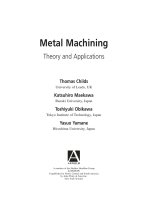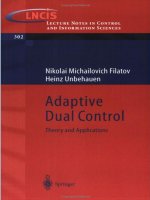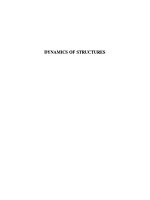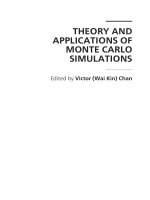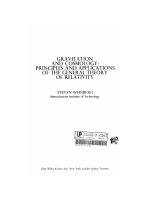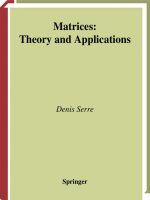- Trang chủ >>
- Khoa Học Tự Nhiên >>
- Vật lý
Impedance spectroscopy, theory experiment and applications macdonald
Bạn đang xem bản rút gọn của tài liệu. Xem và tải ngay bản đầy đủ của tài liệu tại đây (5.68 MB, 606 trang )
Impedance Spectroscopy
Impedance Spectroscopy
Theory, Experiment, and
Applications
Second Edition
Edited by
Evgenij Barsoukov
J. Ross Macdonald
A John Wiley & Sons, Inc., Publication
Copyright © 2005 by John Wiley & Sons, Inc. All rights reserved.
Published by John Wiley & Sons, Inc., Hoboken, New Jersey.
Published simultaneously in Canada.
No part of this publication may be reproduced, stored in a retrieval system, or transmitted in
any form or by any means, electronic, mechanical, photocopying, recording, scanning, or
otherwise, except as permitted under Section 107 or 108 of the 1976 United States Copyright
Act, without either the prior written permission of the Publisher, or authorization through
payment of the appropriate per-copy fee to the Copyright Clearance Center, Inc., 222
Rosewood Drive, Danvers, MA 01923, 978-750-8400, fax 978-646-8600, or on the web at
www.copyright.com. Requests to the Publisher for permission should be addressed to the
Permissions Department, John Wiley & Sons, Inc., 111 River Street, Hoboken, NJ 07030,
(201) 748-6011, fax (201) 748-6008.
Limit of Liability/Disclaimer of Warranty: White the publisher and author have used their
best efforts in preparing this book, they make no representations or warranties with respect
to the accuracy or completeness of the contents of this book and specifically disclaim any
implied warranties of merchantability or fitness for a particular purpose. No warranty may be
created or extended by sales representatives or written sales materials. The advice and
strategies contained herein may not be suitable for your situation. You should consult with a
professional where appropriate. Neither the publisher nor author shall be liable for any loss
of profit or any other commercial damages, including but not limited to special, incidental,
consequential, or other damages.
For general information on our other products and services please contact our Customer
Care Department within the U.S. at 877-762-2974, outside the U.S. at 317-572-3993 or fax
317-572-4002.
Wiley also publishes its books in a variety of electronic formats. Some content that appears
in print, however, may not be available in electronic format.
Library of Congress Cataloging-in-Publication Data:
ISBN: 0-471-64749-7
Printed in the United States of America
10 9 8 7 6 5 4 3 2 1
Contents
Preface
xi
Preface to the First Edition
xiii
Contributors
xv
Contributors to the First Edition
xvii
1. Fundamentals of Impedance Spectroscopy
1
J. Ross Macdonald and William B. Johnson
1.1
Background, Basic Definitions, and History
1.1.1
1.1.2
1.1.3
1.1.4
1.1.5
1.2
9
Differences Between Solid State and Aqueous
Electrochemistry
12
Elementary Analysis of Impedance Spectra
1.3.1
1.3.2
1.3.3
1.4
2
Advantages and Limitations
1.2.1
1.3
1
The Importance of Interfaces
1
The Basic Impedance Spectroscopy Experiment
Response to a Small-Signal Stimulus in the
Frequency Domain
4
Impedance-Related Functions
7
Early History
8
13
Physical Models for Equivalent Circuit Elements
Simple RC Circuits
14
Analysis of Single Impedance Arcs
16
Selected Applications of IS
13
20
2. Theory
27
Ian D. Raistrick, Donald R. Franceschetti, and J. Ross Macdonald
2.1 The Electrical Analogs of Physical and Chemical Processes
2.1.1
2.1.2
Introduction
27
The Electrical Properties of Bulk Homogeneous Phases
29
2.1.2.1 Introduction
29
2.1.2.2 Dielectric Relaxation in Materials with a Single
Time Constant
30
2.1.2.3 Distributions of Relaxation Times
34
2.1.2.4 Conductivity and Diffusion in Electrolytes
42
2.1.2.5 Conductivity and Diffusion—a Statistical
Description
44
2.1.2.6 Migration in the Absence of Concentration Gradients
2.1.2.7 Transport in Disordered Media
49
27
46
v
vi
Contents
2.1.3
2.1.4
2.1.5
2.1.6
2.2
Mass and Charge Transport in the Presence of Concentration
Gradients
54
2.1.3.1 Diffusion
54
2.1.3.2 Mixed Electronic–Ionic Conductors
58
2.1.3.3 Concentration Polarization
60
Interfaces and Boundary Conditions
62
2.1.4.1 Reversible and Irreversible Interfaces
62
2.1.4.2 Polarizable Electrodes
63
2.1.4.3 Adsorption at the Electrode–Electrolyte Interface
66
2.1.4.4 Charge Transfer at the Electrode–Electrolyte Interface
Grain Boundary Effects
72
Current Distribution, Porous and Rough Electrodes—
the Effect of Geometry
74
2.1.6.1 Current Distribution Problems
74
2.1.6.2 Rough and Porous Electrodes
75
68
Physical and Electrochemical Models
2.2.1
2.2.2
2.2.3
80
The Modeling of Electrochemical Systems
80
Equivalent Circuits
81
2.2.2.1 Unification of Immitance Responses
81
2.2.2.2 Distributed Circuit Elements
83
2.2.2.3 Ambiguous Circuits
91
Modeling Results
95
2.2.3.1 Introduction
95
2.2.3.2 Supported Situations
97
2.2.3.3 Unsupported Situations: Theoretical Models
102
2.2.3.4 Unsupported Situations: Equivalent Network Models
2.2.3.5 Unsupported Situations: Empirical and Semiempirical
Models
117
117
3. Measuring Techniques and Data Analysis
3.1
Impedance Measurement Techniques
129
Michael C. H. McKubre and Digby D. Macdonald
3.1.1
3.1.2
3.1.3
Introduction
129
Frequency Domain Methods
130
3.1.2.1
Audio Frequency Bridges
130
3.1.2.2
Transformer Ratio Arm Bridges
133
3.1.2.3
Berberian–Cole Bridge
136
3.1.2.4
Considerations of Potentiostatic Control
139
3.1.2.5
Oscilloscopic Methods for Direct Measurement
140
3.1.2.6
Phase-Sensitive Detection for Direct Measurement
142
3.1.2.7
Automated Frequency Response Analysis
144
3.1.2.8
Automated Impedance Analyzers
147
3.1.2.9
The Use of Kramers–Kronig Transforms
149
3.1.2.10 Spectrum Analyzers
152
Time Domain Methods
154
3.1.3.1
Introduction
154
3.1.3.2
Analog-to-Digital (A/D) Conversion
155
129
Contents
3.1.4
3.2
3.2.2
3.3
3.1.3.3
Computer Interfacing
160
3.1.3.4
Digital Signal Processing
163
Conclusions
167
Commercially Available Impedance Measurement Systems
Brian Sayers
3.2.1
168
Electrochemical Impedance Measurement Systems
168
3.2.1.1
System Configuration
168
3.2.1.2
Why Use a Potentiostat?
169
3.2.1.3
Measurements Using 2, 3 or 4-Terminal Techniques
170
3.2.1.4
Measurement Resolution and Accuracy
171
3.2.1.5
Single Sine and FFT Measurement Techniques
172
3.2.1.6
Multielectrode Techniques
177
3.2.1.7
Effects of Connections and Input Impedance
178
3.2.1.8
Verification of Measurement Performance
180
3.2.1.9
Floating Measurement Techniques
180
3.2.1.10 Multichannel Techniques
181
Materials Impedance Measurement Systems
182
3.2.2.1
System Configuration
182
3.2.2.2
Measurement of Low Impedance Materials
183
3.2.2.3
Measurement of High Impedance Materials
183
3.2.2.4
Reference Techniques
184
3.2.2.5
Normalization Techniques
185
3.2.2.6
High Voltage Measurement Techniques
185
3.2.2.7
Temperature Control
186
3.2.2.8
Sample Holder Considerations
187
Data Analysis
188
J. Ross Macdonald
3.3.1
3.3.2
Data Presentation and Adjustment
188
3.3.1.1 Previous Approaches
188
3.3.1.2 Three-Dimensional Perspective Plotting
189
3.3.1.3 Treatment of Anomalies
192
Data Analysis Methods
194
3.3.2.1 Simple Methods
194
3.3.2.2 Complex Nonlinear Least Squares
195
3.3.2.3 Weighting
197
3.3.2.4 Which Impedance-Related Function to Fit?
197
3.3.2.5 The Question of “What to Fit” Revisited
198
3.3.2.6 Deconvolution Approaches
198
3.3.2.7 Examples of CNLS Fitting
199
3.3.2.8 Summary and Simple Characterization Example
202
4. Applications of Impedance Spectroscopy
4.1
vii
205
Characterization of Materials
205
N. Bonanos, B. C. H. Steele, and E. P. Butler
4.1.1
Microstructural Models for Impedance Spectra of Materials
205
viii
Contents
4.1.2
4.1.3
4.2
Characterization of the Electrical Response of High Resistivity Ionic
and Dielectric Solid Materials by Immittance Spectroscopy
264
J. Ross Macdonald
4.2.1
4.2.2
4.2.3
4.3
4.1.1.1 Introduction
205
4.1.1.2 Layer Models
207
4.1.1.3 Effective Medium Models
215
4.1.1.4 Modeling of Composite Electrodes
223
Experimental Techniques
227
4.1.2.1 Introduction
227
4.1.2.2 Measurement Systems
228
4.1.2.3 Sample Preparation—Electrodes
234
4.1.2.4 Problems Associated With the Measurement of Electrode
Properties
234
Interpretation of the Impedance Spectra of Ionic Conductors
and Interfaces
238
4.1.3.1 Introduction
238
4.1.3.2 Characterization of Grain Boundaries by IS
241
4.1.3.3 Characterization of Two-Phase Dispersions by IS
252
4.1.3.4 Impedance Spectra of Unusual Two-phase Systems
256
4.1.3.5 Impedance Spectra of Composite Electrodes
258
4.1.3.6 Closing Remarks
263
Introduction
264
Types of Dispersive Response Models: Strengths and Weaknesses
4.2.2.1 Overview
265
4.2.2.2 Variable-slope Models
266
4.2.2.3 Composite Models
267
Illustration of Typical Data Fitting Results for an Ionic Conductor
Solid State Devices
265
275
282
William B. Johnson and Wayne L. Worrell
4.3.1 Electrolyte–Insulator–Semiconductor (EIS) Sensors
284
4.3.2 Solid Electrolyte Chemical Sensors
292
4.3.3 Photoelectrochemical Solar Cells
296
4.3.4 Impedance Response of Electrochromic Materials and Devices
302
Gunnar A. Niklasson, Anna Karin Johsson, and Maria Strømme
4.3.4.1 Introduction
302
4.3.4.2 Materials
305
4.3.4.3 Experimental Techniques
306
4.3.4.4 Experimental Results on Single Materials
310
4.3.4.5 Experimental Results on Electrochromic Devices
320
4.3.4.6 Conclusions and Outlook
323
4.3.5 Time-Resolved Photocurrent Generation
325
Albert Goossens
4.3.5.1 Introduction—Semiconductors
325
4.3.5.2 Steady-State Photocurrents
329
4.3.5.3 Time-of-Flight
330
4.3.5.4 Intensity-Modulated Photocurrent Spectroscopy
334
4.3.5.5 Final Remarks
341
Contents
4.4
343
Corrosion of Materials
Digby D. Macdonald and Michael C. H. McKubre
4.4.1
4.4.2
4.4.3
4.4.4
4.4.5
4.4.6
4.4.7
4.4.8
4.4.9
4.5
Introduction
343
Fundamentals
343
Measurement of Corrosion Rate
344
Harmonic Analysis
350
Kramer–Kronig Transforms
356
Corrosion Mechanisms
359
4.4.6.1 Active Dissolution
359
4.4.6.2 Active–Passive Transition
363
4.4.6.3 The Passive State
365
Point Defect Model of the Passive State
382
Digby D. Macdonald
4.4.7.1 Introduction
382
4.4.7.2 Point Defect Model
386
4.4.7.3 Electrochemical Impedance Spectroscopy
389
4.4.7.4 Bilayer Passive Films
408
Equivalent Circuit Analysis
414
Digby D. Macdonald and Michael C. H. McKubre
4.4.8.1 Coatings
419
Other Impedance Techniques
421
4.4.9.1 Electrochemical Hydrodynamic Impedance (EHI)
4.4.9.2 Fracture Transfer Function (FTF)
424
4.4.9.3 Electrochemical Mechanical Impedance
424
Electrochemical Power Sources
4.5.1
4.5.2
422
430
Special Aspects of Impedance Modeling of Power Sources
430
Evgenij Barsoukov
4.5.1.1 Intrinsic Relation Between Impedance Properties and Power
Sources Performance
430
4.5.1.2 Linear Time-Domain Modeling Based on Impedance Models,
Laplace Transform
431
4.5.1.3 Expressing Model Parameters in Electrical Terms, Limiting
Resistances and Capacitances of Distributed Elements
433
4.5.1.4 Discretization of Distributed Elements, Augmenting
Equivalent Circuits
436
4.5.1.5 Nonlinear Time-Domain Modeling of Power Sources
Based on Impedance Models
439
4.5.1.6 Special Kinds of Impedance Measurement Possible with
Power Sources—Passive Load Excitation and Load
Interrupt
441
Batteries
444
Evgenij Barsoukov
4.5.2.1 Generic Approach to Battery Impedance Modeling
444
4.5.2.2 Lead Acid Batteries
457
4.5.2.3 Nickel Cadmium Batteries
459
4.5.2.4 Nickel Metal-hydride Batteries
461
4.5.2.5 Li-ion Batteries
462
ix
x
Contents
4.5.3
4.5.4
Impedance Behavior of Electrochemical Supercapacitors and
Porous Electrodes
469
Brian E. Conway
4.5.3.1 Introduction
469
4.5.3.2 The Time Factor in Capacitance Charge or Discharge
472
4.5.3.3 Nyquist (or Argand) Complex-Plane Plots for
Representation of Impedance Behavior
475
4.5.3.4 Bode Plots of Impedance Parameters for Capacitors
478
4.5.3.5 Hierarchy of Equivalent Circuits and Representation of
Electrochemical Capacitor Behavior
479
4.5.3.6 Impedance and Voltammetry Behavior of Brush
Electrode Models of Porous Electrodes
485
4.5.3.7 Impedance Behavior of Supercapacitors Based on
Pseudocapacitance
489
4.5.3.8 Deviations of Double-layer Capacitance from Ideal Behavior:
Representation by a Constant-phase Element (CPE)
494
Fuel Cells
497
Norbert Wagner
4.5.4.1 Introduction
497
4.5.4.2 Alkaline Fuel Cells (AFC)
509
4.5.4.3 Polymer Electrolyte Fuel Cells (PEFC)
517
4.5.4.4 Solid Oxide Fuel Cells (SOFC)
530
Appendix
539
Abbreviations and Definitions of Models
References
Index
583
541
539
Preface
T
he principal audience that will benefit from this book are M.Sc. and Ph.D. students with specialization in physical chemistry, electrochemistry, or physics, as well
as researchers and engineers in the field of electrochemistry, particularly in areas of
semiconductors, solid electrolytes, corrosion, solid state devices, and electrochemical power sources. Impedance spectroscopy has firmly established itself as one of
the most informative and irreplaceable investigation methods in these areas of
research. In addition, the book provides a valuable source of information and
resource for established researchers and engineers working in one or more of the
above fields.
The book should enable understanding of the method of impedance spectroscopy in general, as well as detailed guidance in its application in all these areas.
It is the only book in existence that brings together expert reviews of all the main
areas of impedance applications. This book covers all the subjects needed by a
researcher to identify whether impedance spectroscopy may be a solution to his/her
particular needs and to explain how to set up experiments and how to analyze their
results. It includes both theoretical considerations and the know-how needed to begin
work immediately. For most subjects covered, theoretical considerations dealing
with modeling, equivalent circuits, and equations in the complex domain are provided. The best measurement methods for particular systems are discussed and
sources of errors are identified along with suggestions for improvement. The extensive references to scientific literature provided in the book will give a solid foundation in the state of the art, leading to fast growth from a qualified beginner to an
expert.
The previous edition of this book became a standard textbook on impedance
spectroscopy. This second extended edition updates the book to include the results
of the last two decades of research and adds new areas where impedance spectroscopy has gained importance. Most notably, it includes completely new sections
on batteries, supercapacitors, fuel cells, and photochromic materials. A new section
on commercially available measurements systems reflects the reality of impedance
spectroscopy as a mainstream research tool.
Evgenij Barsoukov
Dallas, Texas
xi
Preface to the First Edition
Impedance spectroscopy (IS) appears destined to play an important role in fundamental and applied electrochemistry and materials science in the coming years. In
a number of respects it is the method of choice for characterizing the electrical
behavior of systems in which the overall system behavior is determined by a number
of strongly coupled processes, each proceeding at a different rate. With the current
availability of commercially made, high-quality impedance bridges and automatic
measuring equipment covering the millihertz to megahertz frequency range, it
appears certain that impedance studies will become increasingly popular as more
and more electrochemists, materials scientists, and engineers understand the theoretical basis for impedance spectroscopy and gain skill in the interpretation of impedance data.
This book is intended to serve as a reference and/or textbook on the topic of
impedance spectroscopy, with special emphasis on its application to solid materials.
The goal was to produce a text that would be useful to both the novice and the expert
in IS. To this end, the book is organized so that each individual chapter stands on
its own. It is intended to be useful to the materials scientist or electrochemist, student
or professional, who is planning an IS study of a solid state system and who may
have had little previous experience with impedance measurements. Such a reader
will find an outline of basic theory, various applications of impedance spectroscopy,
and a discussion of experimental methods and data analysis, with examples and
appropriate references. It is hoped that the more advanced reader will also find this
book valuable as a review and summary of the literature up to the time of writing,
with a discussion of current theoretical and experimental issues. A considerable
amount of the material in the book is applicable not only to solid ionic systems but
also to the electrical response of liquid electrolytes as well as to solid ones, to electronic as well as to ionic conductors, and even to dielectric response.
The novice should begin by reading Chapter 1, which presents a broad overview
of the subject and provides the background necessary to appreciate the power of the
technique. He or she might then proceed to Chapter 4, where many different applications of the technique are presented. The emphasis in this chapter is on presenting specific applications of IS rather than extensive reviews; details of how and why
the technique is useful in each area are presented. To gain a fuller appreciation of
IS, the reader could then proceed to Chapters 2 and 3, which present the theory and
measuring and analysis techniques.
For someone already familiar with IS, this text will also be useful. For those
familiar with one application of the technique the book will provide both a convenient source for the theory of IS, as well as illustrations of applications in areas
possibly unfamiliar to the reader. For the theorist who has studied IS, the applicaxiii
xiv
Preface to the First Edition
tions discussed in Chapter 4 pose questions the experimentalist would like answered;
for the experimentalist, Chapters 2 and 3 offer different (and better!) methods to
analyze IS data. All readers should benefit from the presentation of theory, experimental data, and analysis methods in one source. It is our hope that this widened
perspective of the field will lead to a more enlightened and thereby broadened use
of IS.
In format and approach, the present book is intended to fall somewhere between
the single-author (or few-author) text and the “monograph” of many authors and as
many chapters. Although the final version is the product of 10 authors’ labors, considerable effort has been made to divide the writing tasks so as to produce a unified
presentation with consistent notation and terminology and a minimum of repetition.
To help reduce repetition, all authors had available to them copies of Sections
1.1–1.3, 2.2, and 3.2 at the beginning of their writing of the other sections. We
believe that whatever repetition remains is evidence of the current importance to IS
of some subjects, and we feel that the discussion of these subjects herein from several
different viewpoints is worthwhile and will be helpful to the readers of the volume.
J. Ross Macdonald
Chapel Hill, North Carolina
March 1987
Contributors
Evgenij Barsoukov
Senior Applications Engineer
Portable Power Management
Texas Instruments Inc.
Nikolaos Bonanos
Senior Research Scientist
Materials Research Department
Risø National Laboratory,
P.O. Box 49, DK-4000 Roskilde
Denmark
Brian Conway
Department of Chemistry
University of Ottawa
Business Address: Marion Hall
140 Louis-Pasteur, Ottawa
On KIN 6N5
Donald Franceschetti
Department of Physics and Chemistry
The University of Memphis
Memphis, TN 38152-6670
Albert Goossens
Delft Department of Chemical
Technology (DelftChemTech)
Faculty of Applied Sciences
Delft University of Technology
Julianalaan 136
2628 BL DELFT
The Netherlands
Digby Macdonald
Director, Center for Electrochemical
Science and Technology
201 Steidle Building
University Park, PA 16802
Dr. J. Ross Macdonald
Department of Physics and Astronomy
University of North Carolina
Chapel Hill, NC 27599-3255, USA
Gunnar A. Niklasson
Department of Materials Science
The Ångstrom Laboratory
Uppsala University
P.O. Box 534
SE-75121 Uppsala, Sweden
Brian Sayers
Product Manager, Solartron Analytical
Unit B1, Armstrong Mall,
Southwood Business Park,
Farnborough,
Hampshire, England GU14 0NR
Norbert Wagner
Deutsches Zentrum für Luft- und
Raumfahrt e.V.
(German Aerospace Center)
Institut für Technische Thermodynamik
Pfaffenwaldring 38-40
D-70569 Stuttgart
xv
Contributors to the First Edition
Nikolaos Bonanos
Senior Research Scientist
Materials Research Department
Risø National Laboratory,
P.O. Box 49, DK-4000 Roskilde
Denmark
E.P. Butler
ALCAN International Ltd.
Banbury Laboratories
Banbury, Tennessee
Donald Franceschetti
Department of Physics
The University of Memphis
Manning Hall, Room 328
Campus Box 526670
Memphis, TN 38152-6670
William B. Johnson
W. L. Gore & Associates
201 Airport Road
P.O. Box 1488
Elkton, MD 21922-1488
Digby Macdonald
Director, Center for Electrochemical
Science and Technology
201 Steidle Building
University Park, PA 16802
Dr. J. Ross Macdonald
(William R. Kenan, Jr., Professor of
Physics, Emeritus)
Department of Physics and Astronomy
University of North Carolina
Chapel Hill, NC 27599-3255, USA
Michael McKubre
Director, SRI International
333 Ravenswood Ave.
Menlo Park, CA 94025-3493
Ian D. Raistrick
Los Alamos National Laboratory
Los Alamos, NM 97545
B. C. H. Steele
Department of Metallurgy and Material
Science
Imperial College of Science and
Technology
London, England
Wayne L. Worrell
Department of Materials
Science and Engineering
University of Pennsylvania
Philadelphia, Pennsylvania
xvii
Chapter
1
Fundamentals of
Impedance Spectroscopy
J. Ross Macdonald
William B. Johnson
1.1 BACKGROUND, BASIC DEFINITIONS,
AND HISTORY
1.1.1 The Importance of Interfaces
Since the end of World War II we have witnessed the development of solid state
batteries as rechargeable high-power-density energy storage devices, a revolution in
high-temperature electrochemical sensors in environmental, industrial, and energy
efficiency control, and the introduction of fuel cells to avoid the Carnot inefficiency
inherent in noncatalytic energy conversion. The trend away from corrosive aqueous
solutions and toward solid state technology was inevitable in electrochemical energy
engineering, if only for convenience and safety in bulk handling. As a consequence,
the characterization of systems with solid–solid or solid–liquid interfaces, often
involving solid ionic conductors and frequently operating well above room temperature, has become a major concern of electrochemists and materials scientists.
At an interface, physical properties—crystallographic, mechanical, compositional, and, particularly, electrical—change precipitously and heterogeneous charge
distributions (polarizations) reduce the overall electrical conductivity of a system.
Proliferation of interfaces is a distinguishing feature of solid state electrolytic cells,
where not only is the junction between electrode and electrolyte considerably more
complex than in aqueous cells, but the solid electrolyte is commonly polycrystalline.
Each interface will polarize in its unique way when the system is subjected to an
applied potential difference. The rate at which a polarized region will change when
the applied voltage is reversed is characteristic of the type of interface: slow for
chemical reactions at the triple phase contacts between atmosphere, electrode, and
electrolyte, appreciably faster across grain boundaries in the polycrystalline elecImpedance Spectroscopy, Second Edition, edited by Evgenij Barsoukov and J. Ross Macdonald
ISBN 0-471-64749-7 Copyright © 2005 by John Wiley & Sons, Inc.
1
2
Chapter 1
Fundamentals of Impedance Spectroscopy
trolyte. The emphasis in electrochemistry has consequently shifted from a time/concentration dependency to frequency-related phenomena, a trend toward small-signal
ac studies. Electrical double layers and their inherent capacitive reactances are characterized by their relaxation times, or more realistically by the distribution of their
relaxation times. The electrical response of a heterogeneous cell can vary substantially depending on the species of charge present, the microstructure of the electrolyte, and the texture and nature of the electrodes.
Impedance spectroscopy (IS) is a relatively new and powerful method of characterizing many of the electrical properties of materials and their interfaces with
electronically conducting electrodes. It may be used to investigate the dynamics of
bound or mobile charge in the bulk or interfacial regions of any kind of solid or
liquid material: ionic, semiconducting, mixed electronic–ionic, and even insulators
(dielectrics). Although we shall primarily concentrate in this monograph on solid
electrolyte materials—amorphous, polycrystalline, and single crystal in form—and
on solid metallic electrodes, reference will be made, where appropriate, to fused salts
and aqueous electrolytes and to liquid-metal and high-molarity aqueous electrodes
as well. We shall refer to the experimental cell as an electrode–material system. Similarly, although much of the present work will deal with measurements at room temperature and above, a few references to the use of IS well below room temperature
will also be included. A list of abbreviations and model definitions appears at the
end of this work.
In this chapter we aim to provide a working background for the practical materials scientist or engineer who wishes to apply IS as a method of analysis without
needing to become a knowledgeable electrochemist. In contrast to the subsequent
chapters, the emphasis here will be on practical, empirical interpretations of materials problems, based on somewhat oversimplified electrochemical models. We shall
thus describe approximate methods of data analysis of IS results for simple solidstate electrolyte situations in this chapter and discuss more detailed methods and
analyses later. Although we shall concentrate on intrinsically conductive systems,
most of the IS measurement techniques, data presentation methods, and analysis
functions and methods discussed herein apply directly to lossy dielectric materials
as well.
1.1.2 The Basic Impedance
Spectroscopy Experiment
Electrical measurements to evaluate the electrochemical behavior of electrode and/or
electrolyte materials are usually made with cells having two identical electrodes
applied to the faces of a sample in the form of a circular cylinder or rectangular parallelepiped. However, if devices such as chemical sensors or living cells are investigated, this simple symmetrical geometry is often not feasible. Vacuum, a neutral
atmosphere such as argon, or an oxidizing atmosphere are variously used. The
general approach is to apply an electrical stimulus (a known voltage or current) to
the electrodes and observe the response (the resulting current or voltage). It is
1.1 Background, Basic Definitions, and History
3
virtually always assumed that the properties of the electrode–material system are
time-invariant, and it is one of the basic purposes of IS to determine these properties, their interrelations, and their dependences on such controllable variables as
temperature, oxygen partial pressure, applied hydrostatic pressure, and applied static
voltage or current bias.
A multitude of fundamental microscopic processes take place throughout the
cell when it is electrically stimulated and, in concert, lead to the overall electrical
response. They include the transport of electrons through the electronic conductors,
the transfer of electrons at the electrode–electrolyte interfaces to or from charged or
uncharged atomic species which originate from the cell materials and its atmospheric
environment (oxidation or reduction reactions), and the flow of charged atoms or
atom agglomerates via defects in the electrolyte. The flow rate of charged particles
(current) depends on the ohmic resistance of the electrodes and the electrolyte and
on the reaction rates at the electrode–electrolyte interfaces. The flow may be further
impeded by band structure anomalies at any grain boundaries present (particularly
if second phases are present in these regions) and by point defects in the bulk of all
materials. We shall usually assume that the electrode–electrolyte interfaces are perfectly smooth, with a simple crystallographic orientation. In reality, of course, they
are jagged, full of structural defects, electrical short and open circuits, and they often
contain a host of adsorbed and included foreign chemical species that influence the
local electric field.
There are three different types of electrical stimuli which are used in IS. First,
in transient measurements a step function of voltage [V(t) = V0 for t > 0, V(t) = 0
for t < 0] may be applied at t = 0 to the system and the resulting time-varying current
i(t) measured. The ratio V0 /i(t), often called the indicial impedance or the timevarying resistance, measures the impedance resulting from the step function voltage
perturbation at the electrochemical interface. This quantity, although easily defined,
is not the usual impedance referred to in IS. Rather, such time-varying results are
generally Fourier or Laplace-transformed into the frequency domain, yielding a
frequency-dependent impedance. If a Fourier-transform is used, a distortion arising
because of the non-periodicity of excitation should be corrected by using windowing. Such transformation is only valid when ͿV0Ϳ is sufficiently small that system
response is linear. The advantages of this approach are that it is experimentally easily
accomplished and that the independent variable, voltage, controls the rate of the electrochemical reaction at the interface. Disadvantages include the need to perform integral transformation of the results and the fact that the signal-to-noise ratio differs
between different frequencies, so the impedance may not be well determined over
the desired frequency range.
A second technique in IS is to apply a signal n(t) composed of random (white)
noise to the interface and measure the resulting current. Again, one generally
Fourier-transforms the results to pass into the frequency domain and obtain an
impedance. This approach offers the advantage of fast data collection because only
one signal is applied to the interface for a short time. The technique has the disadvantages of requiring true white noise and then the need to carry out a Fourier
analysis. Often a microcomputer is used for both the generation of white noise and
4
Chapter 1
Fundamentals of Impedance Spectroscopy
the subsequent analysis. Using a sum of well-defined sine waves as excitation instead
of white noise offers the advantage of a better signal-to-noise ratio for each desired
frequency and the ability to analyze the linearity of system response.
The third approach, the most common and standard one, is to measure impedance by applying a single-frequency voltage or current to the interface and measuring the phase shift and amplitude, or real and imaginary parts, of the resulting current
at that frequency using either analog circuit or fast Fourier transform (FFT) analysis of the response. Commercial instruments (see Section 3.2) are available which
measure the impedance as a function of frequency automatically in the frequency
ranges of about 1 mHz to 1 MHz and are easily interfaced to laboratory microcomputers. The advantages of this approach are the availability of these instruments
and the ease of their use, as well as the fact that the experimentalist can achieve a
better signal-to-noise ratio in the frequency range of most interest. In addition to
these three approaches, one can combine them to generate other types of stimuli.
The most important of these, ac polarography, combines the first and third techniques by simultaneously applying a linearly varying unipolar transient signal and
a much smaller single-frequency sinusoidal signal (Smith [1966]).
Any intrinsic property that influences the conductivity of an electrode–
materials system, or an external stimulus, can be studied by IS. The parameters
derived from an IS spectrum fall generally into two categories: (a) those pertinent
only to the material itself, such as conductivity, dielectric constant, mobilities of
charges, equilibrium concentrations of the charged species, and bulk generation–
recombination rates; and (b) those pertinent to an electrode–material interface, such
as adsorption–reaction rate constants, capacitance of the interface region, and diffusion coefficient of neutral species in the electrode itself.
It is useful and not surprising that modern advances in electronic automation
have included IS. Sophisticated automatic experimental equipment has been developed to measure and analyze the frequency response to a small-amplitude ac signal
between about 10-4 and >106 Hz, interfacing its results to computers and their peripherals (see Section 3.1). A revolution in the automation of an otherwise difficult measuring technique has moved IS out of the academic laboratory and has begun to make
it a technique of significant importance in the areas of industrial quality control of
paints, emulsions, electroplating, thin-film technology, materials fabrication,
mechanical performance of engines, corrosion, and so on.
Although this book has a strong physicochemical bias, the use of IS to investigate polarization across biological cell membranes has been pursued by many investigators since 1925. Details and discussion of the historical background of
this important branch of IS are given in the books of Cole [1972] and Schanne and
Ruiz-Ceretti [1978].
1.1.3 Response to a Small-Signal
Stimulus in the Frequency Domain
A monochromatic signal n(t) = Vm sin(wt), involving the single frequency n ∫ w/2p,
is applied to a cell and the resulting steady state current i(t) = Im sin(wt + q) meas-
1.1 Background, Basic Definitions, and History
5
ured. Here q is the phase difference between the voltage and the current; it is zero
for purely resistive behavior. The relation between system properties and response
to periodic voltage or current excitation is very complex in the time domain. In
general, the solution of a system of differential equations is required. Response of
capacitive and inductive elements is given as i(t) = [dn(t)/dt] C and n(t) = [di(t)/dt]
L correspondingly, and combination of many such elements can produce an intractable complex problem.
Fortunately, the use of Fourier transformation allows one to simplify significantly the mathematical treatment of this system. The above differential equations
can be transformed into I( j w) = C · w · j · V( j w) and I( j w) = ·V( j w)/(L · w · j). Here
j ∫ -1, which is also often denoted in the literature as “i”. For the case of sinewave excitation as above, Fourier transforms of voltage and current V( j w) and
I( j w) become Vmp and Imp · exp(qj) respectively. It can be easily seen that in the
frequency domain voltage/current relations can be rearranged to a form similar to
Ohm’s law for dc current: I( j w) = V( j w)/Z( j w) where for capacitance the complex
quantity Z( j w) is 1/(C · w · j) and for inductance Z( j w) is L · w · j. The complex quantity Z( j w) is defined as the “impedance function”, and its value at a particular frequency is “impedance” of the electric circuit. For simplicity, Z( j w) is usually written
as just Z(w). Because of this Ohm’s law-like relationship between complex current
and voltage, the impedance of a circuit with multiple elements is calculated using
the same rules as with multiple resistors, which greatly simplifies calculations.
Impedance may be defined not only for discrete systems but also for arbitrary
distributed systems as the Fourier transform of the differential equation defining the
voltage response divided by the Fourier transform of the periodic current excitation:
Z( j w) = F{v(t)}/F{i(t)}. Here the F{} operator denotes a Fourier transform.
However, Fourier transformation only reduces differential equations to simple Ohm’s
law-like form under conditions of linearity, causality, and stationarity of the system;
therefore impedance is properly defined only for systems satisfying these conditions.
The concept of electrical impedance was first introduced by Oliver Heaviside
in the 1880s and was soon after developed in terms of vector diagrams and complex representation by A. E. Kennelly and especially C. P. Steinmetz. Impedance is
a more general concept than resistance because it takes phase differences into
account, and it has become a fundamental and essential concept in electrical
engineering. Impedance spectroscopy is thus just a specific branch of the tree of
electrical measurements. The magnitude and direction of a planar vector in a righthand orthogonal system of axes can be expressed by the vector sum of the components a and b along the axes, that is, by the complex number Z = a + jb. The
imaginary number j ∫ -1 ∫ exp( jp/2) indicates an anticlockwise rotation by p/2
relative to the x axis. Thus, the real part of Z, a, is in the direction of the real axis
x, and the imaginary part b is along the y axis. An impedance Z(w) = Z¢ + jZ≤ is such
a vector quantity and may be plotted in the plane with either rectangular or polar
coordinates, as shown in Figure 1.1.1. Here the two rectangular coordinate values
are clearly
Re( Z ) ∫ Z ¢ = Z cos(q ) and Im ( Z ) ∫ Z ¢¢ = Z sin(q )
with the phase angle
(1)
6
Chapter 1
Fundamentals of Impedance Spectroscopy
Figure 1.1.1. The impedance Z plotted as a planar vector using rectangular and polar coordinates.
q = tan -1 ( Z ¢¢ Z ¢)
(2)
and the modulus
[
2
Z = ( Z ¢) + ( Z ¢¢)
2 1/ 2
]
(3)
This defines the Argand diagram or complex plane, widely used in both mathematics
and electrical engineering. In polar form, Z may now be written as Z(w) = ͦZͦ exp( jq),
which may be converted to rectangular form through the use of the Euler relation
exp( jq) = cos(q) + j sin(q). It will be noticed that the original time variations of the
applied voltage and the resulting current have disappeared, and the impedance is
time-invariant (provided the system itself is time-invariant).
In general, Z is frequency-dependent, as defined above. Conventional IS
consists of the (nowadays often automated) measurement of Z as a function of n or
w over a wide frequency range. It is from the resulting structure of the Z(w) vs. w
response that one derives information about the electrical properties of the full electrode–material system.
For nonlinear systems, i.e. most real electrode–material systems, IS measurements in either the time or the frequency domain are useful and meaningful in
general only for signals of magnitude such that the overall electrode–material system
response is electrically linear. This requires that the response to the sum of two separate input-measuring signals applied simultaneously be the sum of the responses of
the signals applied separately. A corollary is that the application of a monochromatic
signal, one involving sin(wt), results in no, or at least negligible, generation of harmonics in the output, that is components with frequencies nn for n = 2, 3, . . . . Both
solid and liquid electrochemical systems tend to show strong nonlinear behavior,
especially in their interfacial response, when applied voltages or currents are large.
But so long as the applied potential difference (p.d.) amplitude Vm is less than the
thermal voltage, VT ∫ RT/F ∫ kT/e, about 25 mV at 25°C, it can be shown that
the basic differential equations which govern the response of the system become
linear to an excellent approximation. Here k is Boltzmann’s constant, T the absolute
1.1 Background, Basic Definitions, and History
7
temperature, e the proton charge, R the gas constant, and F the faraday. Thus if the
applied amplitude Vm is appreciably less than VT, the system will respond linearly.
Note that in the linear regime it is immaterial as far as the determination of Z(w) is
concerned whether a known n(wt) is applied and the current measured or a known
i(wt) applied and the resulting voltage across the cell measured. When the system
is nonlinear, this reciprocity no longer holds.
1.1.4 Impedance-Related Functions
The impedance has frequently been designated as the ac impedance or the complex
impedance. Both these modifiers are redundant and should be omitted. Impedance
without a modifier always means impedance applying in the frequency domain and
usually measured with a monochromatic signal. Even when impedance values are
derived by Fourier transformation from the time domain, the impedance is still
defined for a set of individual frequencies and is thus an alternating-current impedance in character.
Impedance is by definition a complex quantity and is only real when q = 0 and
thus Z(w) = Z¢(w), that is, for purely resistive behavior. In this case the impedance
is completely frequency-independent. When Z¢ is found to be a variable function of
frequency, the Kronig–Kramers (Hilbert integral transform) relations (Macdonald
and Brachman [1956]), which holistically connect real and imaginary parts with each
other, ensure that Z≤ (and q) cannot be zero over all frequencies but must vary with
frequency as well. Thus it is only when Z(w) = Z¢, independent of frequency, so
Z¢ = R, an ordinary linear resistance, that Z(w) is purely real.
There are several other measured or derived quantities related to impedance
which often play important roles in IS. All of them may be generically called immittances. First is the admittance, Y ∫ Z -1 ∫ Y¢ + jY≤. In the complex domain where n,
i, and Z are all taken complex, we can write n = Zi or alternatively i = Yn. It is also
customary in IS to express Z and Y in terms of resistive and capacitance components
as Z = Rs(w) - jXs(w) and Y = Gp(w) + jBp(w), where the reactance Xs ∫ [wCs(w)]-1
and the susceptance Bp ∫ wCp(w). Here the subscripts s and p stand for “series” and
“parallel.”
The other two quantities are usually defined as the modulus function M = jwCc Z
= M¢ + jM≤ and the complex dielectric constant or dielectric permittivity e = M-1 ∫
Y/( jwCc) ∫ e¢ - je ≤. In these expressions Cc ∫ e0Ac/l is the capacitance of the empty
measuring cell of electrode area Ac and electrode separation length l. The quantity
e0 is the dielectric permittivity of free space, 8.854 ¥ 10-12 F/m. The dielectric constant e is often written elsewhere as e* or e to denote its complex character.
Here we shall reserve the superscript asterisk to denote complex conjugation; thus
Z* = Z¢ - jZ≤. The interrelations between the four immittance functions are summarized in Table 1.1.1.
The modulus function M = e-1 was apparently first introduced by Schrama
[1957] and has been used appreciably by McCrum et al. [1976], Macedo et al.
[1972], and Hodge et al. [1975, 1976]. The use of the complex dielectric constant
8
Chapter 1
Fundamentals of Impedance Spectroscopy
Table 1.1.1. Relations Between the Four Basic
Immittance Functionsa
M
M
Z
Y
e
a
Z
Y
e
M
m-1M
mM-1
M-1
mZ
Z
Z-1
m-1Z-1
mY-1
Y-1
Y
m-1Y
e-1
m-1e-1
me
e
m ∫ jwCc, where Cc is the capacitance of the empty cell.
goes back much further but was particularly popularized by the work of Cole and
Cole [1941], who were the first to plot e in the complex plane.
Some authors have used the designation modulus spectroscopy to denote smallsignal measurement of M vs. n or w. Clearly, one could also define admittance and
dielectric permittivity spectroscopy. The latter is just another way of referring to
ordinary dielectric constant and loss measurements. Here we shall take the general
term impedance spectroscopy to include all these other very closely related
approaches. Thus IS also stands for immittance spectroscopy. The measurement and
use of the complex e(w) function is particularly appropriate for dielectric materials,
those with very low or vanishing conductivity, but all four functions are valuable
in IS, particularly because of their different dependence on and weighting with
frequency.
1.1.5 Early History
Impedance spectroscopy is particularly characterized by the measurement and analysis of some or all of the four impedance-related functions Z, Y, M, and e and the
plotting of these functions in the complex plane. Such plotting can, as we shall see,
be very helpful in interpreting the small-signal ac response of the electrode–
material system being investigated. Historically, the use of Z and Y in analyzing the
response of electrical circuits made up of lumped (ideal) elements (R, L, and C) goes
back to the beginning of the discipline of electrical engineering. An important
milestone for the analysis of real systems, that is ones distributed in space, was the
plotting by Cole and Cole [1941] of e¢ and e ≤ for dielectric systems in the complex
plane, now known as a Cole–Cole plot, an adaption at the dielectric constant level
of the circle diagram of electrical engineering (Carter [1925]), exemplified by the
Smith–Chart impedance diagram (Smith [1939, 1944]). Further, Z and/or Y have
been widely used in theoretical treatments of semiconductor and ionic systems
and devices from at least 1947 ( e.g. Randles [1947], Jaffé [1952], Chang and Jaffé
[1952], Macdonald [1953], and Friauf [1954]). Complex plane plots have sometimes
been called Nyquist diagrams. This is a misnomer, however, since Nyquist diagrams
refer to transfer function (three- or four-terminal) response, while conventional
complex plane plots involve only two-terminal input immittances.
1.2 Advantages and Limitations
9
On the experimental side, one should mention the early work of Randles and
Somerton [1952] on fast reactions in supported electrolytes; no complex plane
plotting appeared here. But complex plane plotting of Gp/w vs. Cp was used by
Macdonald [1955] for experimental results on photoconducting alkali halide single
crystals. Apparently the first plotting of impedance in the impedance plane for
aqueous electrolytes was that of Sluyters [1960] (theory) and Sluyters and Oomen
[1960] (experiment). The use of admittance plane plotting for accurate conductivity
determination of solid electrolytes was introduced by Bauerle [1969], the first important paper to deal with IS for ionic solids directly. Since then, there have been many
pertinent theoretical and experimental papers dealing with IS and complex plane
plots. Many of them will be cited later, and we conclude this short survey of early
history pertinent to IS with the mention of three valuable reviews: Sluyters-Rehbach
and Sluyters [1970], Armstrong et al. [1978], and Archer and Armstrong [1980]. The
first and second of these deal almost entirely with liquid electrolytes but are nevertheless somewhat pertinent to IS for solids.
1.2 ADVANTAGES AND LIMITATIONS
Although we believe that the importance of IS is demonstrated throughout this
monograph by its usefulness in the various applications discussed, it is of some value
to summarize the matter briefly here. IS is becoming a popular analytical tool in
materials research and development because it involves a relatively simple electrical
measurement that can readily be automated and whose results may often be
correlated with many complex materials variables: from mass transport, rates of
chemical reactions, corrosion, and dielectric properties, to defects, microstructure,
and compositional influences on the conductance of solids. IS can predict aspects of
the performance of chemical sensors and fuel cells, and it has been used extensively
to investigate membrane behavior in living cells. It is useful as an empirical quality
control procedure, yet it can contribute to the interpretation of fundamental electrochemical and electronic processes.
A flow diagram of a general characterization procedure using IS is presented in
Figure 1.2.1. Here CNLS stands for complex nonlinear least squares fitting (see
Section 3.3.2). Experimentally obtained impedance data for a given electrode–materials system may be analyzed by using an exact mathematical model based on a plausible physical theory that predicts theoretical impedance Zt(w) or by a relatively
empirical equivalent circuit whose impedance predictions may be denoted by Zec(w).
In either the case of the relatively empirical equivalent circuit or of the exact mathematical model, the parameters can be estimated and the experimental Ze(w) data
compared to either the predicted equivalent circuit impedance Zec(w) or to the theoretical impedance Zt(w). Such fitting is most accurately accomplished by the CNLS
method described and illustrated in Section 3.3.2.
An analysis of the charge transport processes likely to be present in an experimental cell (the physical model) will often suggest an equivalent circuit of ideal
resistors and capacitors (even inductors or negative capacitors in some instances)
10
Chapter 1
Fundamentals of Impedance Spectroscopy
Figure 1.2.1. Flow diagram for the measurement and characterization of a material–electrode
system.
and may account adequately for the observed IS response. For example Schouler
et al. [1983] found that the effects of densification by sintering a polycrystalline
electrolyte will reduce the magnitude of the resistance across the grain boundaries
and simultaneously decrease the surface area associated with the interface capacitance. These components will clearly be electrically in parallel in this situation. Their
combination will be in series with other similar subcircuits representing such
processes as the ionization of oxygen at the electrodes.
In another example, the oxidation–reduction reaction for the Zn2+ couple in an
aqueous solution with a dropping mercury electrode (Sluyters and Oomen [1960])
can be represented by a reaction resistance RR, arising from the transfer of electrons
between the electrode and the solution, in parallel with a capacitor CR associated
with the space charge diffuse double layer near the electrode surface. It is not difficult to calculate the theoretical impedance for such a circuit in terms of the parameters RR and CR. From an analysis of the parameter values in a plausible equivalent
circuit as the experimental conditions are changed, the materials system can be
1.2 Advantages and Limitations
11
characterized by analysis of its observed impedance response, leading to estimates
of its microscopic parameters such as charge mobilities, concentrations, and electron transfer reaction rates.
The disadvantages of IS are primarily associated with possible ambiguities in
interpretation. An important complication of analyses based on an equivalent circuit
(e.g. Bauerle [1969]) is that ordinary ideal circuit elements represent ideal lumpedconstant properties. Inevitably, all electrolytic cells are distributed in space, and their
microscopic properties may be also independently distributed. Under these conditions, ideal circuit elements may be inadequate to describe the electrical response.
Thus, it is often found that Ze(w) cannot be well approximated by the impedance of
an equivalent circuit involving only a finite number of ordinary lumped-constant elements. It has been observed by many in the field that the use of distributed impedance elements [e.g. constant-phase elements (CPEs) (see Section 2.2.2.2)] in the
equivalent circuit greatly aids the process of fitting observed impedance data for a
cell with distributed properties.
There is a further serious potential problem with equivalent circuit analysis, not
shared by the direct comparison with Zt(w) of a theoretical model: What specific
equivalent circuit out of an infinity of possibilities should be used if one is necessary? An equivalent circuit involving three or more circuit elements can often be
rearranged in various ways and still yield exactly the same Zec(w). For the different
interconnections the values of the elements will have to be different to yield the
same Zec(w) for all , but an essential ambiguity is present. An example is presented
in Figure 1.2.2. In these circuits the impedance Zi is arbitrary and may be made up
of either lumped elements, distributed elements, or a combination of these types.
Examples of other circuits which demonstrate this type of ambiguity will be presented in Section 2.2.2.3. Which one of two or more circuits which all yield exactly
the same Zec(w) for all w should be used for physicochemical analysis and interpretation? This question cannot be answered for a single set of Ze(w) data alone. An
approach to its solution can only be made by employing physical intuition and by
carrying out several Ze(w) sets of measurements with different conditions, as discussed in Section 2.2.2.3.
Figure 1.2.2. An example of different circuits with the same overall impedance at all frequencies.
